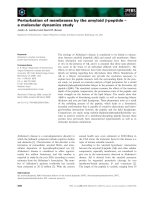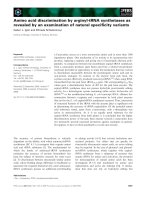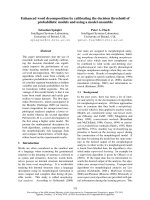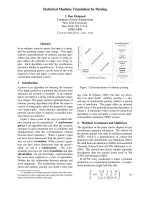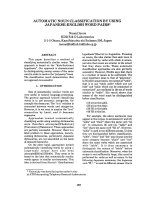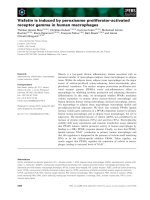báo cáo khoa học: " Mandibular prognathism caused by acromegaly – a surgical orthodontic case" potx
Bạn đang xem bản rút gọn của tài liệu. Xem và tải ngay bản đầy đủ của tài liệu tại đây (1.99 MB, 5 trang )
BioMed Central
Page 1 of 5
(page number not for citation purposes)
Head & Face Medicine
Open Access
Case report
Mandibular prognathism caused by acromegaly – a surgical
orthodontic case
Martin Gosau
1
, Corinna Vogel
2
, Antonios Moralis
1
, Peter Proff
3
,
Johannes Kleinheinz*
4
and Oliver Driemel
1
Address:
1
Department of Cranio-Maxillo-Facial Surgery, University of Regensburg, Regensburg, Germany,
2
Institute of Pathology, University of
Regensburg, Regensburg, Germany,
3
Department of Orthodontics, University of Regensburg, Regensburg, Germany and
4
Department of Cranio-
Maxillofacial Surgery, University of Münster, Münster, Germany
Email: Martin Gosau - ; Corinna Vogel - ;
Antonios Moralis - ; Peter Proff - ;
Johannes Kleinheinz* - ; Oliver Driemel -
* Corresponding author
Abstract
A 22-year-old man presented for orthodontic surgery because of mandibular prognathism. Clinical
symptoms suggested acromegaly, and diagnosis was verified by an endocrinologist as well as by
radiograph. Bilateral mandibular prognathism often represents the first and most striking physical
characteristic of acromegaly; usually, it is also the main reason why patients seek help from
orthodontists or maxillo-facial surgeons. This case report recapitulates the clinical and
histopathological findings in pituitary growth hormone (GH) adenomas and emphasises their
importance in surgical orthodontic planning. Mandibular prognatism, macroglossia and abnormal
growth of hands and feet represent strong indicators for the diagnosis of acromegaly. This disease
and its complications not only affect the entire body but increase mortality if the pituitary gland
tumour remains untreated.
Introduction
Pituitary adenomas have a variety of clinical manifesta-
tions that are related to excessive hormone secretion by
the tumour, hormone deficits by normal pituitary gland
tissue and the expansion of tumour mass. Most patients
have a 5- to 10-year history of changes in facial features
before acromegaly is diagnosed [1,2]. Our case report
recapitulates the clinical and histopathological findings in
pituitary GH adenomas and associated acromegaly and
emphasises their importance in surgical orthodontic plan-
ning.
Clinical history
A 22-year-old man was referred to our hospital for orthog-
nathic surgery after 12 months of presurgical orthodontic
treatment (fig. 1). Physical examination showed pro-
nounced mandibular prognathism, a widened and thick-
ened nose, prominent supraorbital ridges, thick and
coarsened lips and marked facial lines (fig. 2). Intraorally,
macroglossia was evident, impairing speech. The patient
reported that mandibular prognathism had began to
develop 4 years previously. Additionally, his shoe size and
hand size had increased considerably during the last few
months (fig. 3).
Published: 6 August 2009
Head & Face Medicine 2009, 5:16 doi:10.1186/1746-160X-5-16
Received: 2 January 2009
Accepted: 6 August 2009
This article is available from: />© 2009 Gosau et al; licensee BioMed Central Ltd.
This is an Open Access article distributed under the terms of the Creative Commons Attribution License ( />),
which permits unrestricted use, distribution, and reproduction in any medium, provided the original work is properly cited.
Head & Face Medicine 2009, 5:16 />Page 2 of 5
(page number not for citation purposes)
Lateral cephalometric radiograph examination showed
massive mandibular prognathism, prominent supraor-
bital ridges and an enlarged sella turcica (fig. 4). Addition-
ally, magnetic resonance imaging (MRI) scans confirmed
the expansively growing tumour mass within and above
the sella turcica (fig. 5). Furthermore, the entire calvarian
bone was thickened, thus confirming the provisional
diagnosis of acromegaly. The patient had been referred for
examination by an endocrinologist. Diagnosis of a pitui-
tary GH producing macroadenoma was confirmed as well
as reactive hyperprolactinaemia and deficiency of the
gonadotropin axis. Diabetes mellitus was not found.
Endocrinological examination showed increased levels of
the insulin-like growth factor-I (IGF-I) (627.0 ng/ml;
norm: 117.0 to 329.2 ng/ml), increased prolactin (63.69
μg/l; norm: 2.10 to 17.7 μg/l) and depressed testosterone
levels (0.84 μg/l; norm: 2.41 to 8.30 μg/l). Ultrasonogra-
phy showed hepatosplenomegaly and an enlarged left
kidney. In addition, colonoscopy showed dilatation of the
colonic lumen. Ophthalomological screening showed a
large bi-temporal visual field defect due to tumour com-
pression of the optic chiasm. The patient underwent trans-
sphenoidal surgery with complete tumour resection.
Initial intraoral photograph showing Angle class III malocclu-sionFigure 1
Initial intraoral photograph showing Angle class III
malocclusion.
Initial facial photographs (2a: frontal and 2b: lateral view)Figure 2
Initial facial photographs (2a: frontal and 2b: lateral
view).
Initial hands and feet photographFigure 3
Initial hands and feet photograph.
Lateral cephalometric radiographFigure 4
Lateral cephalometric radiograph.
Head & Face Medicine 2009, 5:16 />Page 3 of 5
(page number not for citation purposes)
Histological examination showed a highly vascularised
pituitary adenoma with a diffuse (solid) growth pattern.
Higher magnification showed uniform cells with broad
eosinophilic cytoplasm and round to oval nuclei (fig. 6a).
The proliferation index was very low with approximately
3% of cells showing immunoreactivity against MiB-1 (fig.
6b). Parts of the tumour cells showed immunopositivity
for prolactin in peripheral parts of cytoplasm (fig. 6c).
However, no immunoreactivity was present that provided
an antibody against the human growth hormone (fig. 6d).
Reestablishment of endocrine balance would be followed
by mandibular osteotomies to reestablish facial harmony
and Angle class I occlusion.
Discussion
Since symmetrical mandibular prognathism can be part of
syndromal growth abnormality, this disease is usually
noticeable shortly after birth or in early childhood. Non-
syndromal growth abnormalities of the jaws are mainly
due to genetic or unknown factors. The third group are
acquired growth abnormalities of the jaws. When sym-
metrical bilateral mandibular prognathism is noticed, the
diagnosis of acromegaly should always be taken into con-
sideration [3].
Acromegaly is a rare disease with a prevalence of 40 to 70
cases per million people in the population and an annual
incidence of 3 to 4 new patients per million [4,5]. Owing
to its insidious onset, acromegaly is often diagnosed late
(4 to over 10 years after onset) at an average age of about
40 years. The disease affects men and women equally
[6,7].
In our patient, the diagnosis of acromegaly was consid-
ered because of the patient's manifestations and symp-
toms at first presentation. Mandibular prognathism is
amongst the most commonly found oral manifestations
of acromegaly and it was the main reason for the patient
to seek orthodontic treatment. Enlargement of the lips
and the tongue, such as in our patient, may impair swal-
lowing, chewing and speaking. Frontal bossing, prognath-
ism, macroglossia and an increased size of hands and feet
have often been described in the literature as cosmetic
changes associated with GH adenomas [2,8-10]. All these
changes were present in our patient. Lateral cephalometric
radiograph examination of our patient showed massive
mandibular prognathism, prominent supraorbital ridges
and an enlarged sella turcica. Patients with acromegaly
usually exhibit enlargement of all parts of the neurocra-
nium and orofacial bones except the maxilla. The mandi-
ble usually shows the biggest enlargement, and the ramus
is more affected than the body of the mandible [11,12].
The enlargement of the sella turcica caused by the tumour
expansion of the pituitary gland is a striking manifesta-
tion that is detectable on lateral cephalometric radio-
graphs in almost every patient with acromegaly [5,11,13].
Other symptoms reported by our patient included fatigue,
daytime somnolence and joint pain.
Decreased energy, osteoarthritis and somnolence occur in
about 50% of patients [2,9]. Patients also exhibit cardio-
vascular hypertension, congestive heart failure and
impaired glucose metabolism, but these diseases were not
present in our patient. Diabetes mellitus, sleep apnea
(90%), lumbar stenosis and carpal tunnel syndrome
(20%) are other possible manifestations of GH adenomas
[1,7,14,15]. In adolescents, GH excess manifests clinically
as acromegaly and gigantism if the onset of the disease
occurs before the closure of the epiphyseal plates
[8,10,16].
Adenomas that grow upwards or expand massively, such
as in our patient, may compress the optic chiasm. Such a
compression may lead to visual field defects, which begin
in the superior temporal sectors and then progress to
bitemporal hemianopsia. Persistent compression may
lead to blindness. Routine assessment of visual fields and
acuity is therefore essential.
Measurement of GH response to glucose load is the stand-
ard diagnostic test. An increase in the serum concentration
of IGF-I, the main GH dependent growth factor, confirms
this diagnosis [2,10]. MRI has emerged as the imaging
modality of choice for evaluating pituitary glands [8].
Some adenomas are mixed; mixed GH- and prolactin
(PRL)-secreting adenomas occur frequently (25%). There-
fore, elevated prolactin levels, such as in our patient, are
not unusual.
Available treatment options include surgery, medication
and radiotherapy [16]. Trans-sphenoidal surgery is
regarded as the first-line treatment of acromegaly [9].
MRIs of tumour siteFigure 5
MRIs of tumour site. 5a. coronal 5b. sagittal: MRI scans
show extensive growth in and above the sella turcica with a
total volume of 4.7 × 2.9 × 2.2 cm
3
.
Head & Face Medicine 2009, 5:16 />Page 4 of 5
(page number not for citation purposes)
Depending on the tumour size, long-term remission is
achieved in 50% [9] to 67% [10,17] of patients, but safe
removal of all tumour tissue can be difficult. Microadeno-
mas (less than 10 mm in diameter) are more amenable to
cure. Preoperative GH concentration seems to be the best
indicator for successful treatment and a permanent reduc-
tion of GH and IGF-I [18]. If surgery fails to cure acrome-
galy, medical treatment with somatostatin analogues is
recommended rather than radiotherapy [10]. Regardless
of the initial choice of treatment, patients should be fol-
lowed up indefinitely [2,10,16]. Our patient was treated
with trans-sphenoidal surgery, which adequately reduced
GH and IGF-I levels up to six months postoperatively.
After a permanent reduction of GH and IGF-I levels, the
enlarged soft tissue regresses gradually [19]. However,
only little improvement in bone changes may be
expected. After a stable reduction of GH and IGF-I levels
of at least two years, bimaxillary osteotomy may be con-
ducted for orthognatic correction and reduction of
supraorbital ridges in one single procedure. However, late
relapses may occur due to a recurrence of pituitary gland
adenoma [12,20,21].
Conclusion
Acromegaly is a rare disease that is responsible for bilat-
eral mandibular prognathism in adults. Excess of growth
hormone and local tumour growth of the pituitary gland
affect the entire body and increase mortality. In most
Highly vascularised pituitary adenoma with diffuse (solid) growth patternFigure 6
Highly vascularised pituitary adenoma with diffuse (solid) growth pattern. Higher magnification shows uniform cells
with broad eosinophilic cytoplasm and round to oval nuclei (Hematoxylin and Eosin, A 100×). The proliferation index is very
low with approximately 3% of cells showing immunoreactivity against MiB-1 (B 200×). Some tumour cells show immunopositiv-
ity for prolactin in the peripheral areas of the cytoplasm (C 200×). However, no immunoreactivity was present that provided
an antibody against the human growth hormone (hGH, D 200×).
Publish with BioMed Central and every
scientist can read your work free of charge
"BioMed Central will be the most significant development for
disseminating the results of biomedical research in our lifetime."
Sir Paul Nurse, Cancer Research UK
Your research papers will be:
available free of charge to the entire biomedical community
peer reviewed and published immediately upon acceptance
cited in PubMed and archived on PubMed Central
yours — you keep the copyright
Submit your manuscript here:
/>BioMedcentral
Head & Face Medicine 2009, 5:16 />Page 5 of 5
(page number not for citation purposes)
patients, this disease is diagnosed far too late. Orthodon-
tic and maxillo-facial surgeons dealing with orthognatic
surgery should be well aware of this disease as patients
usually present with them first because of striking man-
dibular growth. In case of mandibular prognatism in com-
bination with enlargement of lips, nose, tongue, hands
and feet followed by visual field defects, sleep apnea,
decreased energy and osteoarthritis, every clinician should
consider the diagnosis of acromegaly. Although acromeg-
aly is a rare disease, its symptoms are striking and can
hardly be misconstrued.
Competing interests
The authors declare that they have no competing interests.
Authors' contributions
GM and MA analysed the patient's history, reviewed all
patient data and drafted the manuscript. VC carried out
the histological analysis, wrote the histological part of the
paper and contributed to the writing of the final version.
DO, PP and KJ were involved in revising the article. Each
author reviewed the paper for content and contributed to
the writing of the manuscript. All authors approved the
final report.
Acknowledgements
Written consent for publication was obtained from the patient.
References
1. Cook DM, Ezzat S, Katznelson L: AACE Acromegaly Guidelines
Task Force. AACE Medical Guidelines for Clinical Practice
for the diagnosis and treatment of acromegaly. Endocrine Prac-
tice 2004, 10:213-225.
2. Vitral RW, Tanaka OM, Fraga MR, Rosa EA: Acromegaly in an
orthodontic patient. Am J Orthod Dentofacial Orthop 2006,
130:388-90.
3. Tornes K, Gilhuus-Moe O: Correction of jaw deformities subse-
quent to treatment of acromegaly. Int J Oral Maxillofac Surg
1986, 15:446-50.
4. Holdaway IM, Rajasoorya C: Epidemiology of acromegaly. Pitui-
tary 1999, 2:29-41.
5. Cohen RB, Wilcox CW: A case of acromegaly identified after
patient complaint of apertognathia. Oral Surg Oral Med Oral
Pathol 1993, 75(5):583-6.
6. Ezzat S, Forster MJ, Berchtold P, Redelmeier DA, Boerlin V, Harris
AG: Acromegaly. Clinical and biochemical features in 500
patients. Medicine (Baltimore) 1994, 73:233-40.
7. Melmed S: Acromegaly. In The Pituitary Edited by: Melmed S. Mal-
den, Mas, USA: Blackwell Science Inc; 2002:419-54.
8. Jane JR Jr, Laws ER Jr: Surgical management of pituitary adeno-
mas. Singapore Med J 2002, 6:318-23.
9. Hurley DM, Ho KKY: Pituitary disease in adults. Med J Aust 2004,
180:419-25.
10. Chanson P, Salenave S: Acromegaly. Review. Orphanet J Rare Dis
2008, 3:1-17.
11. Dostálová S, Sonka K, Smahel Z, Weiss V, Marek J: Cephalometric
assessment of cranial abnormalities in patients with acrome-
galy. J Craniomaxillofac Surg 2003, 31(2):80-7.
12. Chung KC, Buchman SR, Aly HM, Trotman CA: Use of modern
craniofacial techniques for comprehensive reconstruction of
the acromegalic face.
Ann Plast Surg 1996, 36(4):403-8.
13. Sugata T, Myoken Y, Tanaka S: Acromegaly identified in a patient
with a complaint of malocclusion. Oral Surg Oral Med Oral Pathol
Oral Radiol Endod 1998, 85(1):44-6.
14. Klibansk A, Zervas NT: Diagnosis and management of hormone
secreting pituitary adenomas. N Engl J Med 1991, 324:822-31.
15. Cuccia AM, Campisi G, Cannavale R, Colella G: Obesity and
craniofacial variables in subjects with obstructive sleep
apnea syndrome: comparisons of cephalometric values.
Head Face Med 2007, 22:41.
16. Arafah BM, Nasrallah MP: Pituitary tumors: pathophysiology,
clinical manifestations and management. Endocr Relat Cancer
2001, 8:287-305.
17. Laws ER, Vance ML, Thapar K: Pituitary surgery for the manage-
ment of acromegaly. Horm Res 2000, 53:71-5.
18. Nomikos P, Buchfelder M, Fahlbusch R: The outcome of surgery
in 668 patients with acromegaly using current criteria of bio-
chemical "cure". Eur J Endocrinol 2005, 152:379-87.
19. Sugar A: Surgical correction of residual facial deformity fol-
lowing treatment of acromegaly. J Maxillofac Surg 1986,
14(1):14-7.
20. Yagi T, Kawakami M, Takada K: Surgical Orthodontic Correction
of Acromegaly with Mandibular Prognathism. Angle Orthod
2004, 74:125-131.
21. Jackson IT, Meland NB, Keller EE, Sather AH: Surgical correction
of the acromegalic face. A one stage procedure with a team
approach. J Craniomaxillofac Surg 1989, 17(1):2-8.

